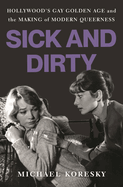
From 1934 to 1968, the Motion Picture Production Code kept Hollywood movies scrubbed clean of queer content--or so enforcers thought. Some filmmakers responded to the Production Code with another kind of code: the queer coding that Michael Koresky (Films of Endearment) identifies, dissects with uncommon insight, and celebrates in Sick and Dirty: Hollywood's Gay Golden Age and the Making of Modern Queerness.
Koresky dives deep into a handful of cornerstone Code-era queer-coded films, noting that in them, "queerness is perceptible as a trace, as a wink, as an identity, as a sensibility." In Alfred Hitchcock's Rope (1948), the unspoken homosexuality of its two male leads, who are clearly cohabitating, is, like the body of the man they've killed, hiding in plain sight. Koresky explores his chosen films' origin stories, their sociopolitical contexts, and the fights (there were always fights) to get them made, albeit often in compromised form. Lillian Hellman's 1934 play, The Children's Hour, in which a charge of lesbianism against two headmistresses threatens their school, became These Three, a 1936 film that swapped out the source material's queer allusions for a heterosexual love triangle. The story's lesbianism would ultimately be, as Koresky puts it, "done 'right' " in a 1961 film treatment.
Koresky is a beautiful writer, and his scholarship accommodates bursts of lightheartedness. He devotes a chapter to Judy Garland because "any endeavor to describe the contours, discernible or not, of queer cinematic history would be incomplete without her." That history comes to shimmering, affirming life in Sick and Dirty. --Nell Beram, author and freelance writer

